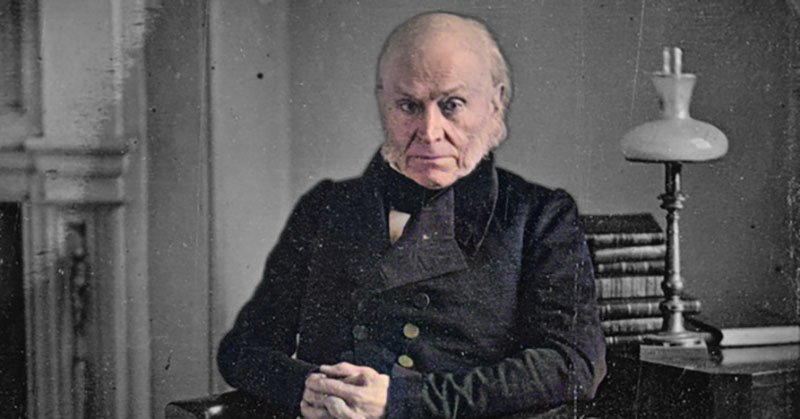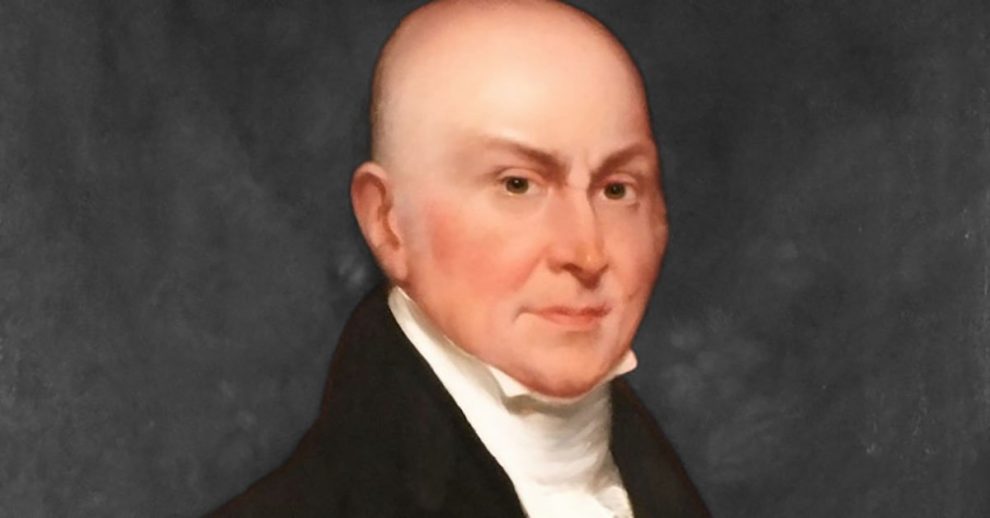John Quincy Adams was born into revolution and raised for diplomacy. The son of John and Abigail Adams, he first crossed the Atlantic at age 10 on a mission with his father and began public service before most boys finished school. He studied at Harvard, spoke half a dozen languages, and witnessed the birth of modern nations while serving in Europe. At home he was known for his dry humor, strict self-discipline, and daily walks of six miles, often through snow or rain. Fiercely principled and famously blunt, Adams lived by the motto “Duty is ours; results are God’s,” a creed that guided him through one of the most extraordinary careers in American public life. Keep reading the 25 facts below to discover how his brilliance, quirks, and convictions shaped U.S. history in unforgettable ways.
America’s First Presidential Son

1. John Quincy Adams, elected in 1824 as the 6th President of the United States, broke several firsts in American history. He was the first president who was not a Founding Father, the first to be the son of a former president, and the first to marry a foreign-born First Lady, Louisa Catherine Johnson of England. His unique background marked a new generation of American leadership, bridging the revolutionary era with the early republic.
2. In 1828, during one of America’s dirtiest presidential elections, opponents of John Quincy Adams accused him of acting as a “pimp” while serving as a diplomat in Russia. A rival journalist, Isaac Hill, claimed Adams had procured an American girl for Russian Czar Alexander I years earlier. The baseless smear was part of a broader campaign of mudslinging that marred the bitter race between Adams and Andrew Jackson.
3. While serving as president in the 1820s, John Quincy Adams reportedly supported funding an expedition to the Earth’s center based on the Hollow Earth theory. Believers claimed that entrances at the North and South Poles led to a subterranean world inhabited by “Mole People.” Though the plan never left the ground, the bizarre proposal became one of the strangest episodes associated with Adams’s time in office.
4. As president, John Quincy Adams kept a pet alligator at the White House, reportedly housed in the East Room. He received the reptile as a regift from the Marquis de Lafayette. Adams supposedly sometimes used it to scare his visitors.
5. John Quincy Adams began most mornings with a nude swim in Washington’s Potomac River. One day, journalist Anne Royall stumbled upon him bathing and famously hid his clothes until he agreed to offer her an interview, making her the first woman to interview a U.S. president. Despite once nearly drowning during one of his swims, Adams ignored his doctor’s warnings and continued the risky ritual of early morning skinny dipping.
6. In 1821, John Quincy Adams completed a massive 268-page Report on Weights and Measures after 3½ years of study. Tasked with deciding whether the United States should adopt the French metric system, Adams concluded that such a switch would be too difficult for the young nation. Congress never acted on his findings, leaving America to continue with its traditional system.
7. When John Quincy Adams became the 6th President of the United States in 1825, he broke with tradition during his inauguration. Instead of placing his hand on a Bible, Adams chose a book of law to symbolize his commitment to the Constitution and justice.
8. In 1836, Congress passed a gag rule to silence debate over slavery, but former President John Quincy Adams, then serving in the House, refused to be silenced. Despite repeated attempts to censure him, he defiantly presented thousands of antislavery petitions over the next eight years. Adams’s relentless stand for free speech helped lead to the rule’s repeal in 1844.
9. In 1824, Andrew Jackson won pluralities of both the popular and electoral votes, but no candidate secured a majority, so the House of Representatives in Washington held a contingent election in early 1825. Speaker Henry Clay threw his support to John Quincy Adams, helping Adams win the presidency. Adams then named Clay Secretary of State, prompting Jackson’s supporters to denounce a “Corrupt Bargain” that fueled Jackson’s successful 1828 campaign.
10. After losing his reelection in 1828, former President John Quincy Adams rejected retirement and won nine consecutive elections to the U.S. House of Representatives, serving from 1830 until his death in 1848. Driven by his opposition to Andrew Jackson, hatred of slavery, and dislike of idleness, Adams became one of the most active congressmen of his era. Over his long career, he also served as a senator, secretary of state, and ambassador to Prussia, Portugal, the Netherlands, and the United Kingdom, and even declined a Supreme Court appointment.
The White House Billiard Backlash

11. In 1825, President John Quincy Adams bought a secondhand billiard table, re-felted it, and installed it in the White House. A House committee’s 1826 report mistakenly listed the table and accessories among items funded by a $14,000 furnishing appropriation, and Adams’s opponents used the listing to attack him as extravagant and to link billiards to gambling; Adams said he had paid for it himself. In 1827, a congressional clarification and a Treasury certification stated no public funds were used, but the controversy still fed Jacksonian attacks and helped set the sour tone of the 1828 campaign.
12. In 1791, a 24-year-old John Quincy Adams ignored his mother’s warnings and stared directly at a solar eclipse without protection. The risky decision damaged his eyesight, leaving him partially blinded for life. Adams later recorded the incident in his diary as a painful lesson in both science and caution.
13. In 1841, former President John Quincy Adams stood before the U.S. Supreme Court at age 72 to argue the Amistad case. Nearly blind and long retired from practicing law, Adams defended a group of Africans who had seized control of a Spanish slave ship and were imprisoned in the United States. His powerful argument helped secure their freedom, marking what many historians regard as the nation’s first major civil rights case.
14. Among the first twelve U.S. presidents, ten owned slaves. The only exceptions were the father and son pair, John Adams and John Quincy Adams, who never owned slaves.
15. Inside the U.S. Capitol’s National Statuary Hall lies an architectural oddity, a “whisper chamber,” where sound travels cleanly between two focal points of the room’s elliptical shape. John Quincy Adams, whose desk sat at one of those points, reportedly used the phenomenon to eavesdrop on his political rivals’ conversations across the chamber.
16. In March 1843, John Quincy Adams made history as the first U.S. president ever photographed. The former president posed for a daguerreotype, the earliest form of photography, years after leaving office. The image captured a rare glimpse of America’s early statesmen in the dawn of the photographic age.
17. Throughout his political career, John Quincy Adams shifted alliances across five major parties. He began as a Federalist, then served as a Democratic-Republican, joined the National Republicans, supported the Anti-Masonic movement, and finally aligned with the Whigs. His political evolution reflected the turbulent and transforming landscape of early American politics.
18. Before becoming famous for his revolver, Samuel Colt designed underwater mines intended for naval warfare. Although they worked effectively, President John Quincy Adams rejected the project, calling it “not fair and honest warfare” and labeling the mines an “unchristian contraption.” After the rejection, Colt abandoned explosives and turned his inventive focus to firearms instead.
19. In 1815, Louisa Catherine Adams braved a perilous journey across war-torn Europe with her young son to reunite with her husband, John Quincy Adams, in London. Decades later, when she died in 1852, Congress adjourned for her funeral, which was the first time in U.S. history it had ever done so for a woman.
20. Three of John Quincy Adams’s sons, George, John, and Charles Francis, fell in love with their orphaned cousin, Mary Catherine Hellen, who lived with the family after her parents died. When Mary chose to marry Charles Francis in 1829, his brothers refused to attend the wedding.
Adams Survives America’s First Train Crash

21. In 1833, a train derailed in New Jersey and caused a crash that killed two passengers and injured 21 others, including Cornelius Vanderbilt, who broke a leg. Former President John Quincy Adams, riding in a forward coach, escaped unhurt and later described the scene in his diary as the most dreadful catastrophe he had ever witnessed.
22. To pay for new furniture, President Chester A. Arthur cleared out old White House belongings in a public sale. The items reportedly included Abraham Lincoln’s pants and hats once worn by John Quincy Adams. In all, the staff hauled away 24 wagons of goods for the public to buy.
23. In 1820, Secretary of State John Quincy Adams commissioned engraver William J. Stone to create 200 official copies of the Declaration of Independence to preserve the fading original. Completed in 1823, each copperplate print bore the signatures exactly as they appeared on the original and was distributed to major U.S. institutions. Over 180 years later, in 2006, one of these rare Stone copies resurfaced at a Nashville thrift shop. It was brought by a man for $2.48, and later it was auctioned for $477,650.
24. When John Quincy Adams collapsed on the floor of the U.S. House of Representatives in 1848, he was immediately carried to the Speaker’s Room, where he died two days later. His final words were reportedly, “This is the last of earth; I am content.” Fittingly, the man known as “Old Man Eloquent” died in the very chamber where he had spent his last years passionately defending liberty and opposing slavery.
25. From age 12 until his death at 80, John Quincy Adams kept a diary almost every day, filling more than 15,000 pages across 51 volumes. His entries documented everything from the American Revolution to his presidency and final years in Congress, offering one of the most detailed personal records in U.S. history. Historians later called it an unmatched window into the nation’s political and moral evolution.














Add Comment